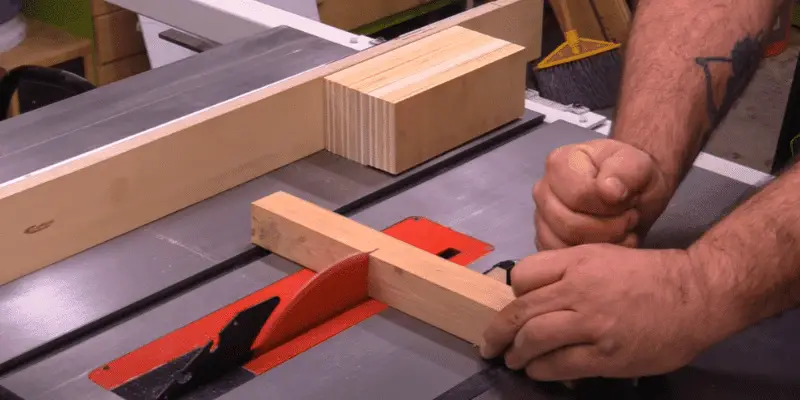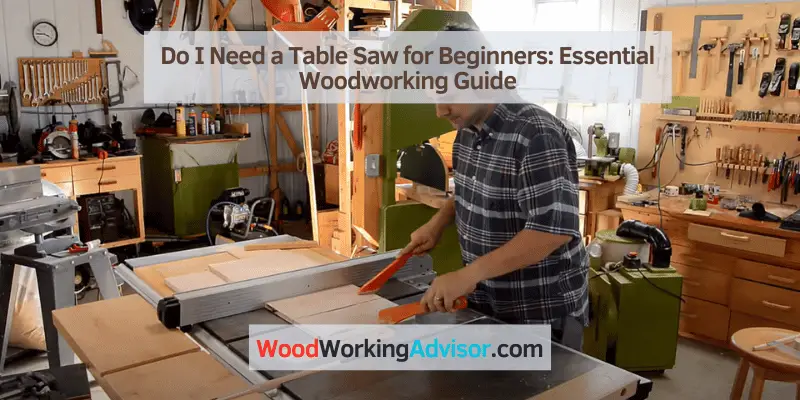For beginners, a table saw is not a necessity, but it can be helpful for certain projects. Understanding the basics of woodworking and building techniques is more important for beginners than owning specific tools.
However, as you progress and take on more complex projects, a table saw can become a valuable addition to your workshop. When starting out in woodworking, it’s natural to wonder if a table saw is essential. While it’s not imperative for beginners, it can certainly make certain tasks easier.
As you gain more experience and tackle larger projects, the versatility and precision of a table saw may become increasingly beneficial. It’s important to prioritize learning foundational skills and safety practices before investing in specific tools like a table saw. This will allow you to make informed decisions based on your own woodworking needs and preferences.
Table Saw’s Role In Essential Woodworking
For beginners in woodworking, a table saw plays a crucial role in cutting wood with precision and efficiency. Its versatility makes it a valuable tool for various woodworking projects, providing accurate cuts for creating different pieces. As a beginner, investing in a table saw can greatly enhance your woodworking skills and capabilities.
Importance In A Beginner’s Tool Arsenal
As a beginner woodworker, adding a table saw to your tool arsenal unlocks a world of possibilities. With its capability to make precise cuts and various woodworking applications, a table saw is a fundamental tool for anyone starting their woodworking journey. This versatile tool can be used to make essential woodworking joints such as rabbets, dadoes, and tenons, enabling beginners to tackle a wide range of projects from simple to complex.
Types Of Woodworking Projects Achievable
A table saw opens the door to a multitude of woodworking projects for beginners. From constructing basic furniture pieces like tables and shelves to advanced projects such as cabinetry and custom woodworking designs, a table saw offers the ability to create precise cuts and shapes. This makes it an indispensable tool for those looking to explore different woodworking techniques and projects.
Versatility And Precision Enhancement
The versatility and precision of a table saw contribute significantly to a beginner’s woodworking journey. Its ability to rip, crosscut, miter, and bevel wood with accuracy empowers woodworkers to experiment and refine their skills. Additionally, the enhanced precision offered by a table saw ensures that each cut is crisp and uniform, contributing to the overall quality and professional finish of woodworking projects.
Evaluating Your Woodworking Ambitions
When diving into the world of woodworking, your aspirations and goals will ultimately shape the tools you need. Evaluating your woodworking ambitions early on will help you make informed decisions about the equipment you invest in. Table saws are a staple in many woodworking shops, but do you really need one as a beginner? Let’s break down the key considerations to help you assess the necessity of a table saw and determine if it aligns with your woodworking ambitions.
Assessing The Necessity Of A Table Saw
Before rushing into the world of table saws, it’s essential to assess whether it’s a necessity for your woodworking projects. Consider the type of woodworking projects you plan to undertake and whether a table saw is indispensable for achieving your desired results.
Determining The Scale Of Projects And Investment
Think about the scale of your woodworking projects and the level of investment you are willing to make. If you’re aiming for larger-scale projects that require precise cuts and diverse woodworking techniques, then a table saw may indeed be a valuable investment.
Long-term Benefits Vs. Initial Costs
Evaluate the long-term benefits of owning a table saw versus the initial costs involved. While the upfront investment may seem substantial, a quality table saw can offer long-term advantages in terms of efficiency, precision, and versatility in your woodworking endeavors.
Do I Need A Table Saw For Beginners
When starting out in the world of woodworking, one of the fundamental questions beginners often ask themselves is, “Do I need a table saw?” The allure of this powerful cutting tool, capable of making precision cuts and clean rip cuts, can be difficult to resist. However, the decision to invest in a table saw as a beginner requires careful consideration. In this article, we will explore the key considerations, safety and skill level requirements, and space and maintenance needs to help you make an informed decision about whether you need a table saw as a beginner.
Key Considerations Before Purchasing
Before rushing into purchasing a table saw, it’s important to consider several key factors. Budget plays a significant role, as table saws can range from affordable to high-end models with advanced features. Workspace is another crucial aspect to consider, as table saws require ample space for operation and storage. Additionally, you’ll want to evaluate the type of cuts you’ll be making and the material you’ll be working with. All these factors will play a vital role in determining whether a table saw is necessary for your woodworking projects as a beginner.
Safety And Skill Level Requirements
When contemplating the necessity of a table saw, it’s essential to assess your skill level and familiarity with using power tools. Table saws demand a certain level of proficiency and respect for safety measures. Consider whether you’re equipped with the knowledge and experience to operate a table saw safely. Safety features should also be a priority when considering a table saw, as these can greatly mitigate the risk of injuries. Additionally, investing in safety gear and equipment may be necessary to ensure your safety while using a table saw.
Understanding The Space And Maintenance Needs
Space and maintenance requirements are essential considerations for beginners contemplating the purchase of a table saw. A table saw requires a dedicated workspace with sufficient room for maneuvering and material support, as well as for storage when not in use. Additionally, maintenance needs to be factored in, as regular cleaning, blade changes, and lubrication are necessary to ensure the longevity and performance of the table saw. Understanding and addressing these requirements are vital for making an informed decision about integrating a table saw into your woodworking setup as a beginner.
Choosing Your First Table Saw
When choosing your first table saw, it’s crucial to consider the features and capabilities that align with your project demands, as well as the price ranges and best value models available. To make an informed decision, evaluating these aspects is essential in ensuring that your table saw will meet your needs as a beginner woodworker.
Evaluating Features And Specifications
Before making a purchase, it’s important to evaluate the features and specifications of various table saw models. Consider looking for the following key features:
- Blade size and type: Opt for a saw with a standard blade size, such as 10 inches, which is versatile for a range of projects.
- Motor power: Look for a higher horsepower motor for smoother cuts, especially for thicker or hardwood materials.
- Fence system: A reliable fence system ensures accurate and consistent cuts, crucial for precise woodworking.
- Dust collection: Built-in dust collection systems help maintain a clean workspace and improve visibility while cutting.
- Safety features: Ensure that the table saw has essential safety features such as a blade guard, riving knife, and a reliable power switch.
Aligning Saw Capabilities With Project Demands
Assessing the capabilities of a table saw in relation to your project demands is vital. Consider the types of projects you plan to undertake and how the saw’s features align with those demands. For instance, if you foresee working on larger-scale projects, a table saw with a sturdy build, ample power, and a spacious tabletop would be beneficial. Alternatively, if precision is your priority, a saw with advanced fence systems and miter gauges might be more suitable.
Price Ranges And Best Value Models
When it comes to price ranges, table saws vary widely based on their features, capabilities, and brand. It’s essential to explore different options and their respective price points to find the best value for your budget. Look for models that offer a good balance of quality, performance, and affordability, ensuring that you get the most out of your investment as a beginner woodworker.

Essential Table Saw Skills Guide
As a beginner in woodworking, learning essential table saw skills is fundamental in creating quality and precise cuts. Understanding the fundamental cuts and how to make them, utilizing jigs and accessories to enhance functionality, and practicing on projects to build proficiency are key to mastering the table saw.
Fundamental Cuts And How To Make Them
When using a table saw, it’s essential to grasp the fundamental cuts that form the basis of woodworking projects. These include the rip cut, crosscut, miter cut, bevel cut, and the dado cut. Each of these cuts serves a specific purpose in woodworking, and understanding how to make them accurately is crucial for achieving precision in your projects.
Jigs And Accessories To Enhance Functionality
Using jigs and accessories can significantly enhance the functionality of your table saw. Jigs such as crosscut sleds, taper jigs, dado jigs, and tenoning jigs can help in achieving complex and precise cuts, while accessories like push sticks, featherboards, and blade guards contribute to safety and control. Learning how to use these tools effectively can elevate the capabilities of your table saw.
Practice Projects To Build Proficiency
Practice is essential in honing your table saw skills. Starting with simple projects like cutting boards, picture frames, and small furniture pieces allows you to familiarize yourself with the operation of the table saw and improve your precision. As you progress, you can move on to more complex projects that require intricate cuts and techniques, further building your proficiency with the table saw.
Frequently Asked Questions On Do I Need A Table Saw For Beginners
Is A Table Saw Necessary For Beginners?
A table saw can enhance accuracy and efficiency for beginners tackling woodworking projects. While not essential, it provides valuable features for various cuts and materials, especially for those eager to refine their skills.
What Are The Benefits Of Using A Table Saw As A Beginner?
Utilizing a table saw offers increased precision, seamless cuts, and improved versatility for beginners. This tool aids in mastering various woodworking techniques and enables the creation of intricate designs with ease.
Can Beginners Use Alternative Tools Instead Of A Table Saw?
Beginners can explore alternatives like circular saws or miter saws for their woodworking projects. These tools offer similar cutting capabilities and can be more cost-effective and versatile for beginners in different scenarios.
Should Beginners Invest In A Table Saw?
Investing in a quality table saw can significantly benefit beginners in their woodworking journey. It provides enhanced safety features, precise cutting abilities, and facilitates a broader range of projects, making it a valuable long-term asset for enthusiasts.
Conclusion
Table saws can be beneficial for beginners due to their versatility and efficiency in various woodworking projects. While they may seem intimidating at first, with proper safety measures and practice, they can greatly enhance your woodworking abilities. Ultimately, whether a beginner needs a table saw depends on their specific projects and comfort level with power tools.


